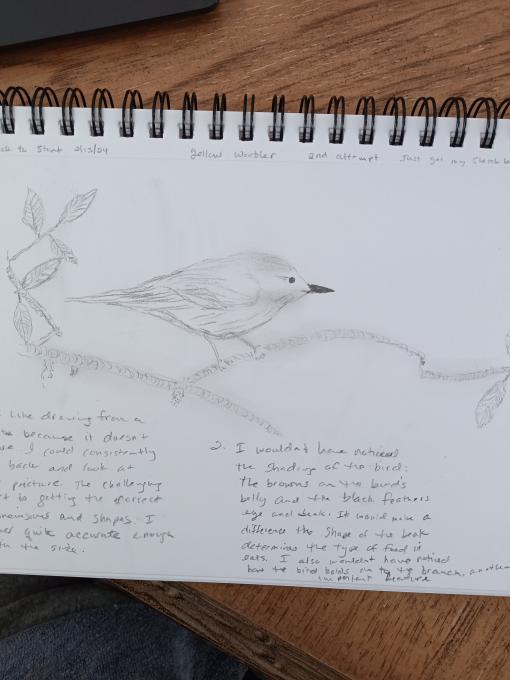Heidi
Forum Replies Created
-
HeidiParticipantI love how you got the look of the feathers and the coloring on the head and wing. I also like how you captured the texture of the branches. I need to figure out how to do that. It's beautiful!in reply to: See How Far You’ve Come #1021178
-
HeidiParticipantIt took me a while to finish my after drawing, and I know I have a long way to go. However, I do see improvement. I need to work on holding a brush and getting finer lines. My hand shakes, so it is tricky. I also need to work on color blending and learning how to create more 3-d shapes. Even though I worked on being patient, I need to work on that more. The first photo is my very first drawing before I got my materials, and it is my final drawing. The second one I posted was right after I got my materials and watched the first drawing video.

 in reply to: See How Far You’ve Come #1021176
in reply to: See How Far You’ve Come #1021176 -
HeidiParticipantMy favorite experience happened after finishing the section on chiaroscuro and suddenly seeing highlights in objects, paintings, and photographs. It sounds like such a simple thing, but I had never really noticed it before. The same thing happened after finishing the section on mixing colors and suddenly noticing the nuance of colors in the everyday objects around me. I also loved drawing the song sparrow upside down and having it look like the actual picture I was copying. One of my most frustrating experiences was working on filling a sketch with color, attempting to erase a slight pencil mark where I wanted to place the eye of a bird, and smudging the still-wet section. Ugh. Lesson learned.
 in reply to: Tips to Keep You Going #1019671
in reply to: Tips to Keep You Going #1019671 -
HeidiParticipant
@Suzanne I've been meaning to thank you for this advice. It will be helpful as I get out and attempt to capture more landscapes. The weather has been awful each weekend when I try to get outside. Hopefully, it will change soon. It still feels like February in Massachusetts.
in reply to: Noticing Themes in Nature #1019642 -
HeidiParticipantMy first experience with nature writing was when I started teaching high school English. It seems impossible, but I had never read Henry David Thoreau until I started teaching over 30 years ago. I taught American Lit to a bunch of 11th graders and eventually 10th graders when we shifted the curriculum. Don’t ask how I managed to miss this icon of nature writing during all of my schooling. I couldn’t tell you. But as I read passages from Walden for the first time, I was captivated by his links between the natural world, everyday life, and emotions. I started assigning photo essays to my students and eventually learned about the Walden Woods Thoreau Summer Institute. During that time, we read various books, essays, and poems from Walden to “Walking” to Cape Cod and beyond. I took students to the woods in town, and they observed, took pictures, and wrote. Some loved it; most students saw it as a way to get out of classes for the day, but all understood the importance of maintaining open spaces in their communities. Places where they could go to shake off a bad day, contemplate life, and listen to the world of the woods. I started seeking out more writers. I enjoy reading David Gessner and Mary Oliver’s works and continue exploring various authors. Each writer brings a different part of the country to light. I especially love Mary Oliver’s essay “Owls,” published in Owls and Other Fantasies: “But the great horned I can’t imagine in any such proximity-- if one of those should touch me, it would touch the center of my life, and I must fall. They are the pure wild hunters of our world.” Her words capture the essence of a being so beautiful and powerful. Over the years, I have gone into Hopedale Parklands, sat, listened, and written about my thoughts. It’s forced me to look at everything in nature differently. I see two trees emerging from a common stump and envision people buried upside down, only hips and legs protruding from the earth. I hear the wind move through the trees and know it’s the fall wind pulling at crisp leaves or the winter wind no longer buffered by them. I’m so glad the email for this class popped up unexpectedly in my inbox just as I was thinking about taking a beginner art class. After taking this class, I see light, reflection, and color in ways I hadn’t before. It is another step closer to learning how to capture the essence of what I see and hear. Art is not my forte by any stretch, but I now understand better how to capture some images that I want to ponder more deeply in my writing.in reply to: The Power of Reflection #1019638
-
HeidiParticipantI just did the practice painting today because I need to order new watercolors, but I can already see how the techniques can help with images. I will try the idea of creating rough textures with the dry-on-dry technique with trees. The wet-on-dry will be fun to experiment with when painting some birds with deep and vibrant colors, such as cardinals and goldfinches. Looking at other people's journal entries makes me excited to get started. I added a picture of my faulty paint set and my practice:(

 in reply to: Getting Comfortable with Watercolor #1016426
in reply to: Getting Comfortable with Watercolor #1016426 -
HeidiParticipantYes! Very frustrating! I thought it was me, and then I saw your entry.in reply to: Capturing Nature’s Color Palettes #1016424
-
HeidiParticipantUnfortunately, this lesson ended quickly when I discovered the Koi Water Colors palette I ordered didn't come with gray or black, and most of the colors were fluorescent. I will order a new palette and return to this lesson.in reply to: Capturing Nature’s Color Palettes #1016423
-
HeidiParticipantAs I go through these steps, I’m getting better at judging size and shape, but it is difficult to create white space when the outer lines of the wings are white. I was trying to refine a duck drawing, and the intricate wing patterns were extremely difficult to capture due to the mix of white, grey, and black feathers that crossed over layers of other feathers. It’s the detail that is frustrating to capture. I know that will take a lot of time and practice.

 in reply to: Giving Your Drawings Depth #1014894
in reply to: Giving Your Drawings Depth #1014894 -
HeidiParticipantIt was difficult and fun to see how the picture emerged. I’m also learning that I’m even more impatient than I thought. These lessons are forcing me to slow down and take my time. I could move even more slowly, but I am getting better at paying attention to lines and shapes. I think I still initially viewed the subject as an upside-down sparrow, but as I moved through the exercise, I focused on the shapes much more. When I did that, it was easier to keep moving along. I was counting lines and ovals and not thinking so much about trying to draw a bird.

 in reply to: Drawing What You See – Upside Down Drawing #1014878
in reply to: Drawing What You See – Upside Down Drawing #1014878 -
HeidiParticipantAlthough I find it tricky, it is definitely helpful when figuring out how to capture images on the page more accurately. The weather is not conducive to getting outside to do this in the field, so I am stuck with objects in the house for now. I’m hoping to get out tomorrow. The easy part if getting the measurement at the top; the hard part is moving the pencil down to count out the size. This was tricky for a stationary object. I can’t imagine what it will be like with one that jumps around. In doing this assignment, I definitely found my observation skills improving. I drew walrus tusks that have been hanging on my wall for approximately 8 years and I never realized there were carvings on the sides before. If I get outside tomorrow, I will comment on the measurements of various subjects.


 in reply to: Getting the Proportions Right #1014863
in reply to: Getting the Proportions Right #1014863 -
HeidiParticipantI do think it is helping with observation. With the red fox, I could see how the kit vied for mom’s attention. It was licking her. She seemed a bit tired and needed a rest. She would move away, and the kit would come back… It was challenging to draw and observe. They moved a lot! I did notice how alert the mother was. She constantly moved and looked outward as the kit was licking her and trying to cuddle. She was very aware of her surroundings. This activity has given me even more appreciation for the work of artists in the nature drawings I have seen.in reply to: Capturing Behavior – Gesture Drawing #1013667
-
HeidiParticipantI think your springbok is impressive as are the others.in reply to: Focusing on Your Subject – Blind Contour Drawing #1013663
-
HeidiParticipantIf Blind contour drawing isn’t a lesson in humility, I don’t know what is. I’m looking at pictures of beautiful creatures, ones I have loved since I was young, and trying to capture their form on a page while not looking at the page. I thought my sketching experience couldn’t get much worse until today. I’m glad the instructor told us we would need to be able to laugh at ourselves and our drawings because that’s about all I could do. I found that I could focus on my subject and see the details of the skin, feathers, fur, and shapes, but it was very difficult to keep myself from looking down. I had to tell myself not to do it several times despite wanting to peak so badly. I was able to hold off until the end and then look at my abstract drawings. When I showed my husband, he could guess at the possible species: lizard, chicken, kelp, bull, and Ireland he stated. Newt, sunbird, bird of paradise, springbok, and cypress tree, I replied. It was simultaneously a fun and frustrating experience:) I've included a picture of my Green-tailed sunbird/chicken blind contour drawing for your entertainment:)
 in reply to: Focusing on Your Subject – Blind Contour Drawing #1013662
in reply to: Focusing on Your Subject – Blind Contour Drawing #1013662 -
HeidiParticipantI love the beak study. I wish I could draw like your artist friend!in reply to: The Power of Comparison #1011853
-
HeidiParticipantI did the comparison with some Valentine/Birthday flowers because it is cold here today!

 in reply to: The Power of Comparison #1011851
in reply to: The Power of Comparison #1011851 -
HeidiParticipant

 I'm definitely struggling with creating depth in the landscapes. Hopefully, that lesson will come soon:) I also realize I don't have a lot of patience for drawing lots of details. There are so many trees that made sketching very complex for my basic skills. in reply to: Noticing Themes in Nature #1011672
I'm definitely struggling with creating depth in the landscapes. Hopefully, that lesson will come soon:) I also realize I don't have a lot of patience for drawing lots of details. There are so many trees that made sketching very complex for my basic skills. in reply to: Noticing Themes in Nature #1011672 -
HeidiParticipantToday, I sat by the water's edge of Seymore Pond in Brewster, MA. I have a home here, so I often sit on my deck in the summer, record the conditions, and write in my journal. But I haven't done it in February on a 30-degree day. I brought my chair down to the beach for a more immersive experience. Today, there is a forlorn mood because everything is a muted grey at various scales. Even the scrub pines' green needles have a grey feel because of the light snow falling and the solid grey sky. Now that I’m back in the house and up above the water at the treen line, the needles are a brighter green, but nothing is vibrant. The dead trees are coated on the north side with snow from Tuesday’s storm. It is a strange, almost perfect stripe up the sides of the trunks. Despite the lifeless feel, I could see several buffleheads swimming on the opposite side of the pond, and my Merlin app recorded various songbirds, from Cardinals to Carolina wrens. It also caught the song of a common loon. I did spot the female cardinal, but I didn’t see any of the other birds from my spot. Even though it felt forlorn, it also felt peaceful. Before I left, a mallard couple swam nearby, but as soon as they spotted me, they lifted off and flapped away. I folded my chair and walked back up to the house, chilled but satisfied.in reply to: Opening Your Senses #1011425
-
HeidiParticipant
 I can SEE how the skills can be applied, but I can't quite figure out how to get the ideas to work on the page. I tried to draw a grapefruit (that looks like a pomegranate) and could see the light and dark spaces. I also noticed how many little dots there are on a grapefruit I had never seen before. I used stippling to capture that effect and tried to use the highlight, light, and shadow to capture the light and dark. Although I feel more comfortable putting marks on the page, I have a long way to go. in reply to: Illustrating the 3D World #1010719
I can SEE how the skills can be applied, but I can't quite figure out how to get the ideas to work on the page. I tried to draw a grapefruit (that looks like a pomegranate) and could see the light and dark spaces. I also noticed how many little dots there are on a grapefruit I had never seen before. I used stippling to capture that effect and tried to use the highlight, light, and shadow to capture the light and dark. Although I feel more comfortable putting marks on the page, I have a long way to go. in reply to: Illustrating the 3D World #1010719 -
HeidiParticipant
 in reply to: Jump Right in! #1010697
in reply to: Jump Right in! #1010697
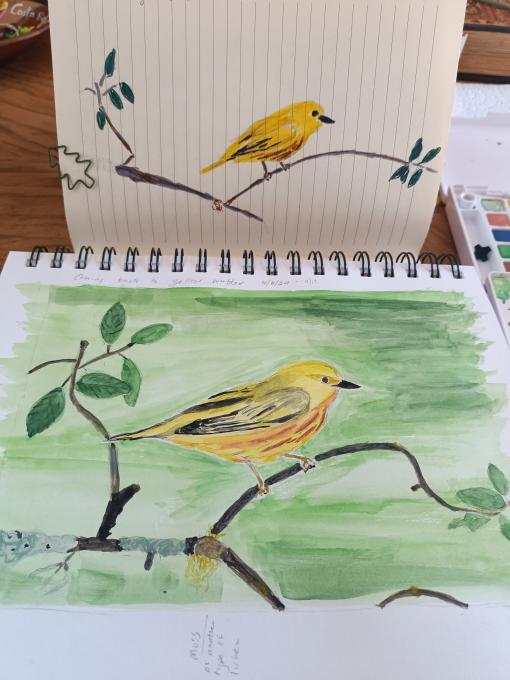
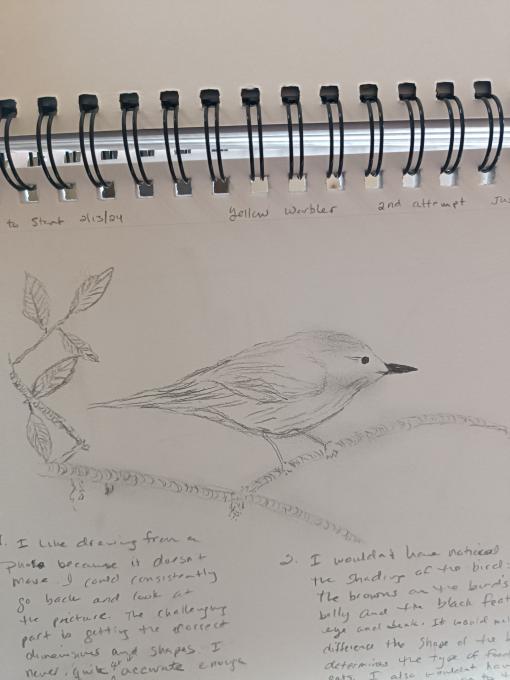
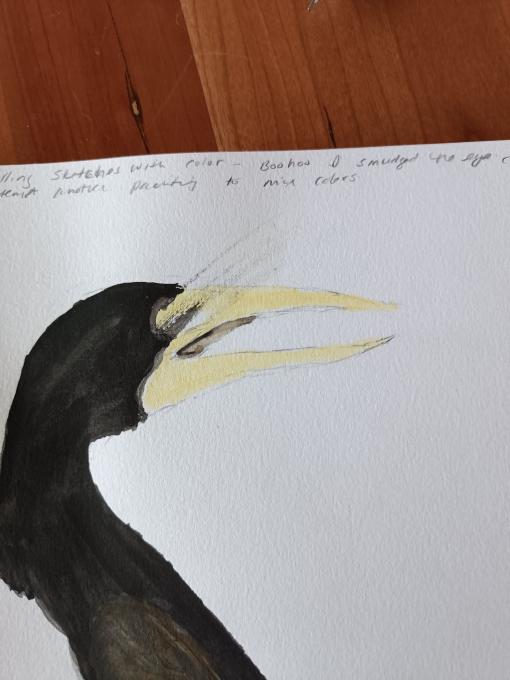

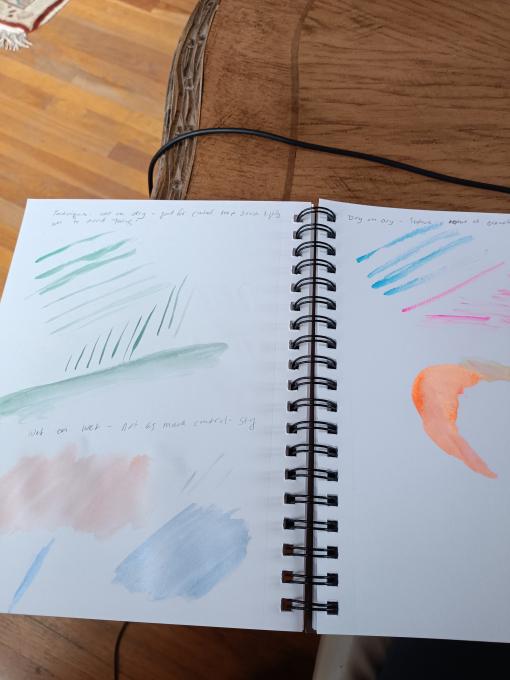
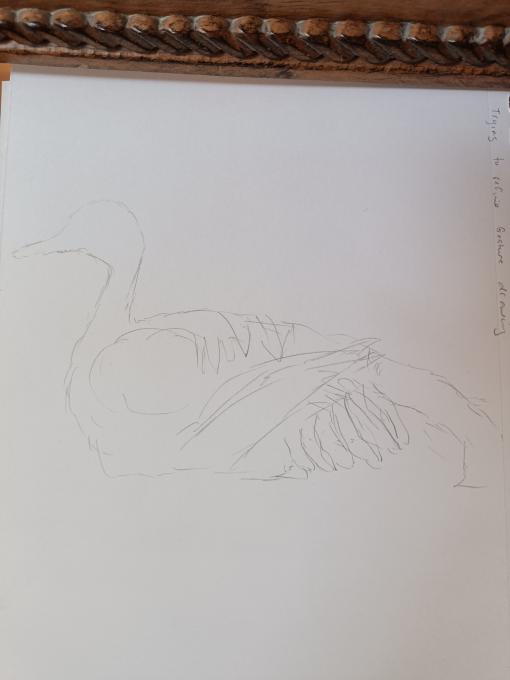
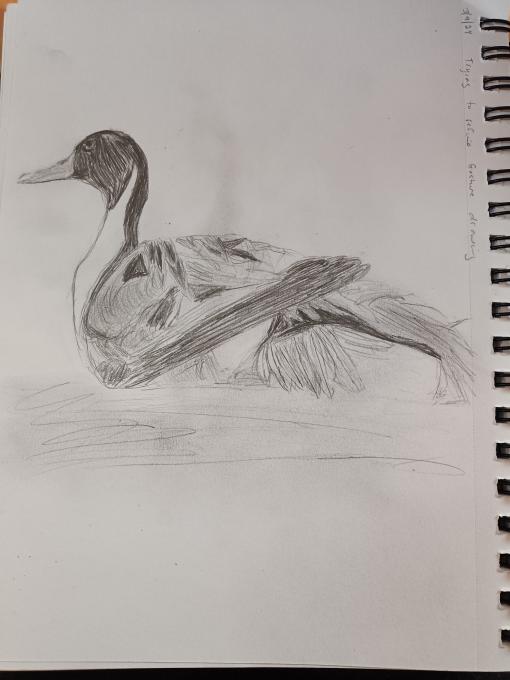

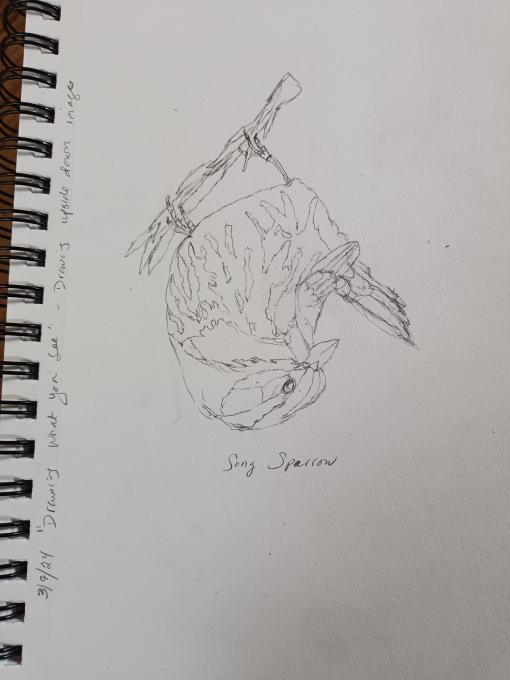
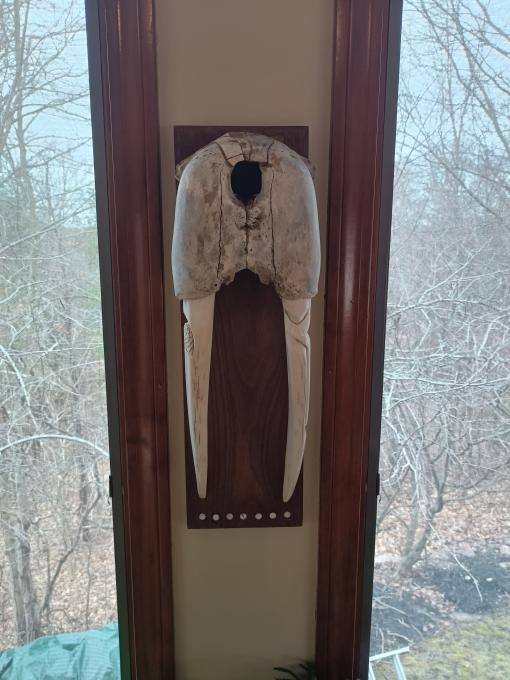
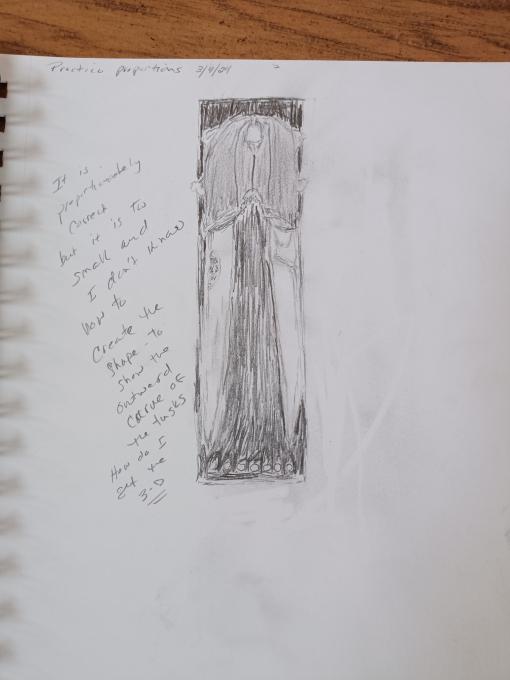
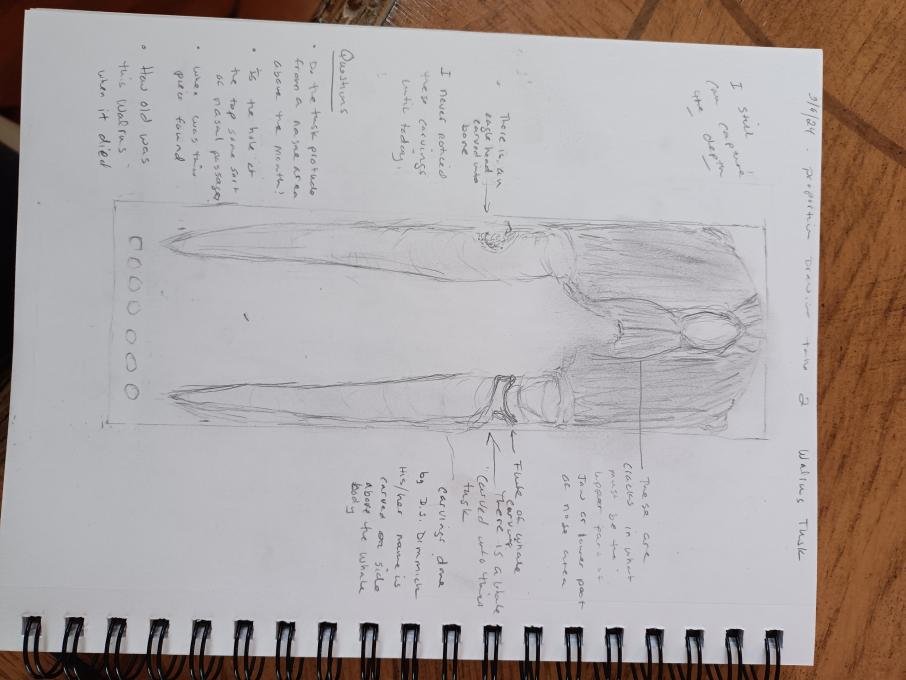
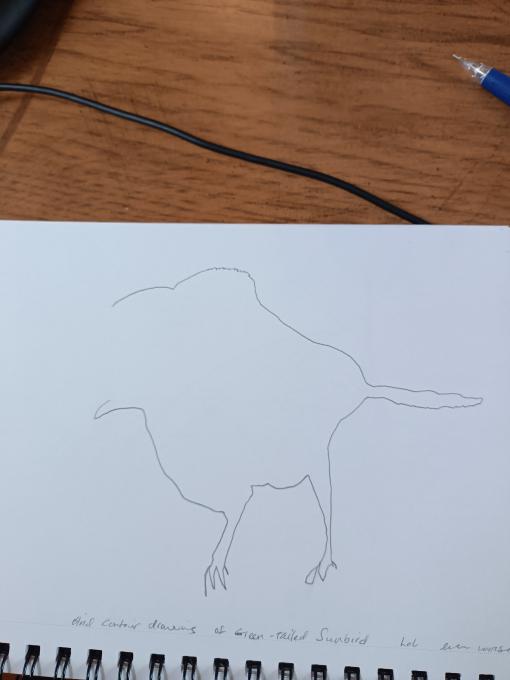

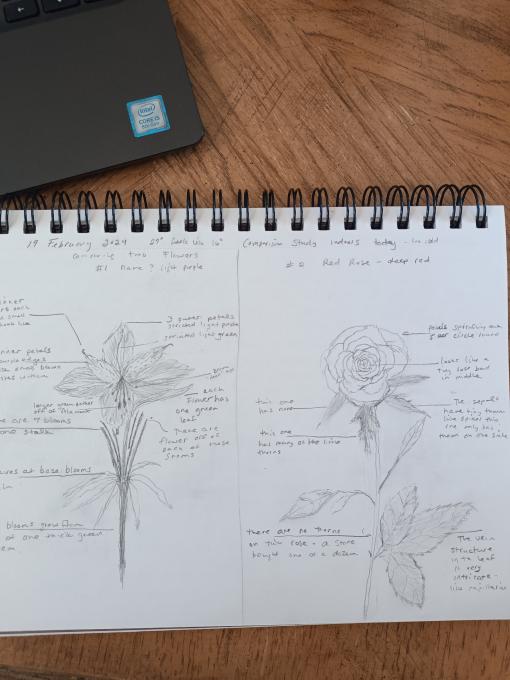
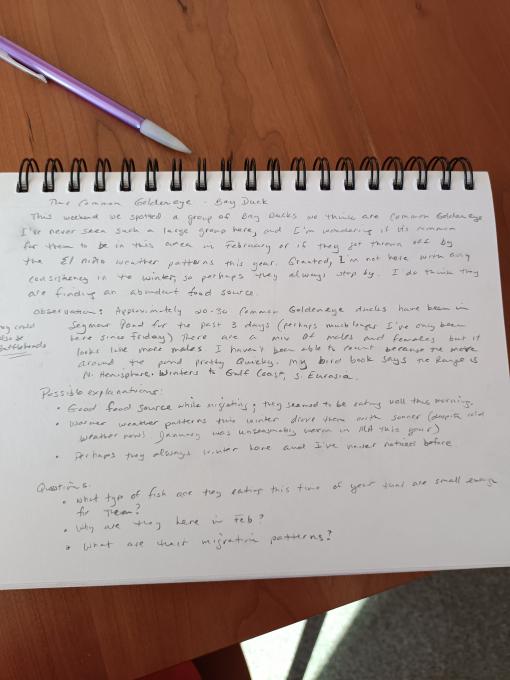
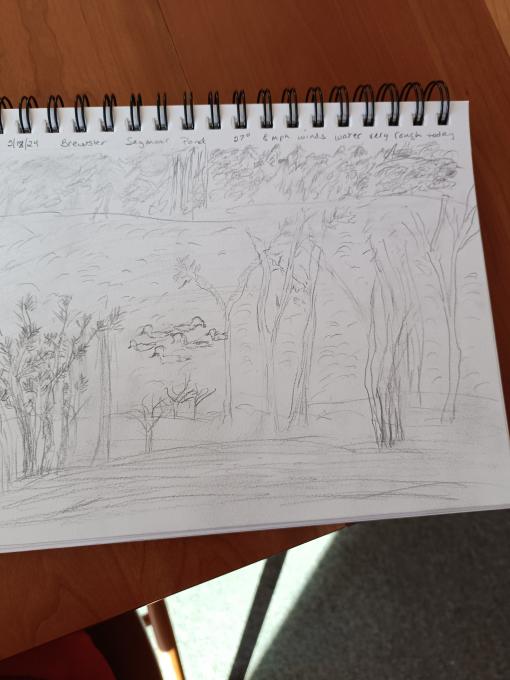 I'm definitely struggling with creating depth in the landscapes. Hopefully, that lesson will come soon:) I also realize I don't have a lot of patience for drawing lots of details. There are so many trees that made sketching very complex for my basic skills.
I'm definitely struggling with creating depth in the landscapes. Hopefully, that lesson will come soon:) I also realize I don't have a lot of patience for drawing lots of details. There are so many trees that made sketching very complex for my basic skills. 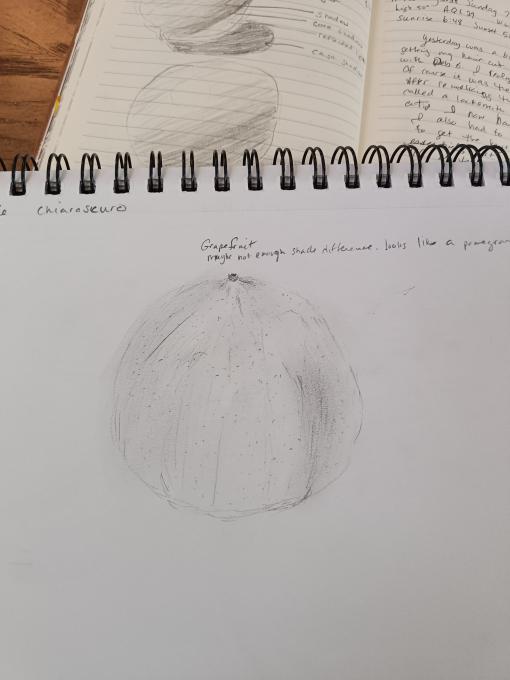 I can SEE how the skills can be applied, but I can't quite figure out how to get the ideas to work on the page. I tried to draw a grapefruit (that looks like a pomegranate) and could see the light and dark spaces. I also noticed how many little dots there are on a grapefruit I had never seen before. I used stippling to capture that effect and tried to use the highlight, light, and shadow to capture the light and dark. Although I feel more comfortable putting marks on the page, I have a long way to go.
I can SEE how the skills can be applied, but I can't quite figure out how to get the ideas to work on the page. I tried to draw a grapefruit (that looks like a pomegranate) and could see the light and dark spaces. I also noticed how many little dots there are on a grapefruit I had never seen before. I used stippling to capture that effect and tried to use the highlight, light, and shadow to capture the light and dark. Although I feel more comfortable putting marks on the page, I have a long way to go. 